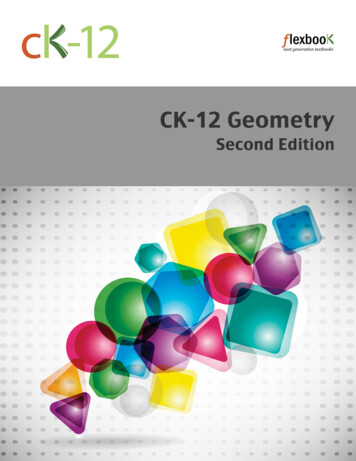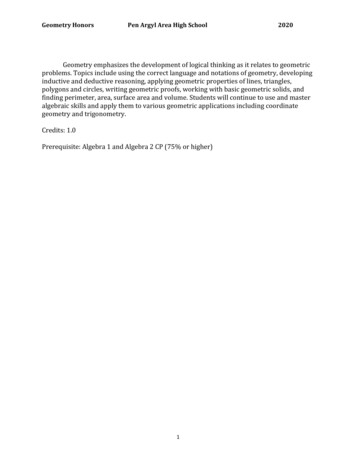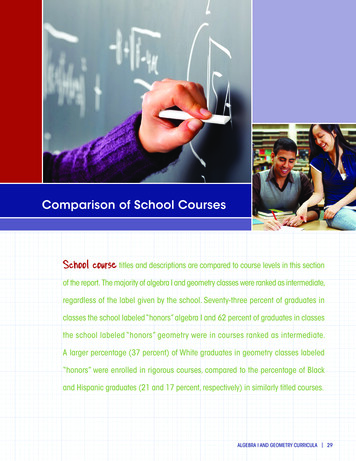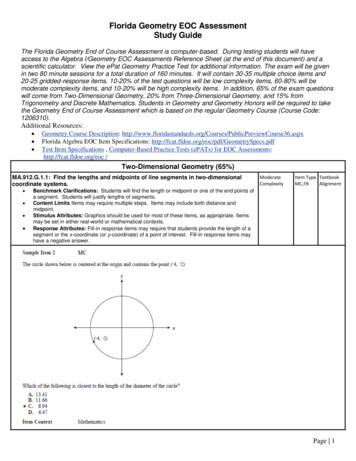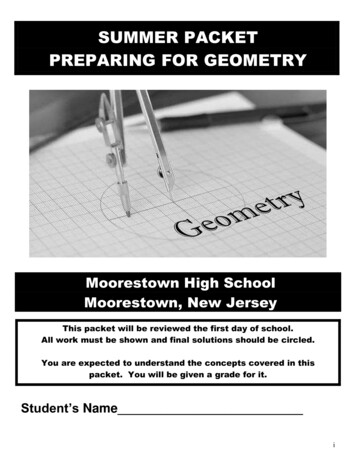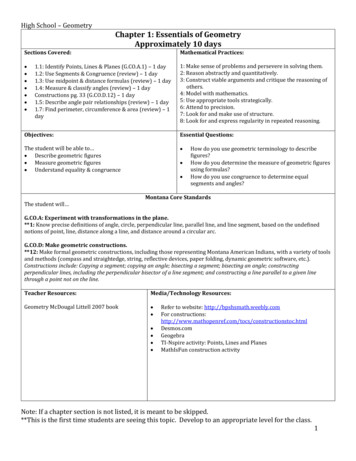
Transcription
High School – GeometryChapter 1: Essentials of GeometryApproximately 10 daysSections Covered:Mathematical Practices: 1: Make sense of problems and persevere in solving them.2: Reason abstractly and quantitatively.3: Construct viable arguments and critique the reasoning ofothers.4: Model with mathematics.5: Use appropriate tools strategically.6: Attend to precision.7: Look for and make use of structure.8: Look for and express regularity in repeated reasoning.1.1: Identify Points, Lines & Planes (G.CO.A.1) – 1 day1.2: Use Segments & Congruence (review) – 1 day1.3: Use midpoint & distance formulas (review) – 1 day1.4: Measure & classify angles (review) – 1 dayConstructions pg. 33 (G.CO.D.12) – 1 day1.5: Describe angle pair relationships (review) – 1 day1.7: Find perimeter, circumference & area (review) – 1dayObjectives:Essential Questions:The student will be able to Describe geometric figures Measure geometric figures Understand equality & congruence How do you use geometric terminology to describefigures?How do you determine the measure of geometric figuresusing formulas?How do you use congruence to determine equalsegments and angles?Montana Core StandardsThe student will G.CO.A: Experiment with transformations in the plane.**1: Know precise definitions of angle, circle, perpendicular line, parallel line, and line segment, based on the undefinednotions of point, line, distance along a line, and distance around a circular arc.G.CO.D: Make geometric constructions.**12: Make formal geometric constructions, including those representing Montana American Indians, with a variety of toolsand methods (compass and straightedge, string, reflective devices, paper folding, dynamic geometric software, etc.).Constructions include: Copying a segment; copying an angle; bisecting a segment; bisecting an angle; constructingperpendicular lines, including the perpendicular bisector of a line segment; and constructing a line parallel to a given linethrough a point not on the line.Teacher Resources:Media/Technology Resources:Geometry McDougal Littell 2007 book Refer to website: http://bpshsmath.weebly.comFor tructionstoc.htmlDesmos.comGeogebraTI-Nspire activity: Points, Lines and PlanesMathIsFun construction activityNote: If a chapter section is not listed, it is meant to be skipped.**This is the first time students are seeing this topic. Develop to an appropriate level for the class.1
High School – GeometryAssessments:Suggested Instructional Practices: Constructions are essential for the following MVP Module 6. Homework: To be given daily on eachintroduced topic.Class discussion: Students will be expectedto be prepared for class, participate in classactivities and actively engage in classdiscussion.Formative Assessments: On currentchapter concepts.Summative Assessments: On conceptsinvolving the essentials of geometry.Note: If a chapter section is not listed, it is meant to be skipped.**This is the first time students are seeing this topic. Develop to an appropriate level for the class.2
High School – GeometryMVP Module 6: Congruence, Constructions & ProofApproximately 28 daysSections Covered:Mathematical Practices: 1: Make sense of problems and persevere in solving them.2: Reason abstractly and quantitatively.3: Construct viable arguments and critique the reasoning ofothers.4: Model with mathematics.5: Use appropriate tools strategically.6: Attend to precision.7: Look for and make use of structure.8: Look for and express regularity in repeated reasoning. 6.1: Leaping Lizards (G.CO.A.1, 4, 5) – 2 days6.2: Is It Right? (G.CO.A.1, 5) – 2 days6.3: Leap Frog (G.CO.A.4, 5) – 2 days6.4: Leap Year (G.CO.A.1, 2, 4, 5) – 2 days6.5: Symmetries of Quadrilaterals (G.CO.A.3, 6) – 2 days6.6: Symmetries of Regular Polygons (G.CO.A.3, 6) – 1day6.7: Quadrilaterals Beyond Definition (G.CO.A.3, 4, 6) –2 daysSuggested that 6.1-6.7 be assessed together6.8: Can You Get There From Here? (G.CO.A.5) – 1 day6.9: Congruent Triangles (G.CO.A.6, 7, 8) – 1 day6.10: Congruent Triangles To The Rescue (G.CO.A.7, 8) –2 days6.11: Under Construction (G.CO.A.12, 13) – 2 days6.12: More Things Under Construction (G.CO.A.12, 13) –2 days6.13: Justifying Constructions (G.CO.A 12, 13) – 2 days6.14: Constructions Blueprints (G.CO.A.12, 13) – 1 daySuggested that 6.8-6.14 be assessed togetherObjectives:Essential Questions:The student will be able to Develop, write, & apply definitions of rigid motiontransformations. Examine slopes of perpendicular and parallel lines. Find rotational symmetry and lines of symmetry inspecial types of quadrilaterals. Examine characteristics of regular polygons thatemerge from rotational symmetry and lines ofsymmetry. Make sense of and justify properties of quadrilateralsusing symmetry transformations. Describe a sequence of transformations that mapcongruent images onto each other. Establish ASA, AAS, and SSS for congruent triangles. Explore, examine, and write compass and straightedgeconstructions How do you prove 2 figures are congruent using rigidmotion?How do you construct rhombus, squares, andparallelograms using only a compass and straightedge?Can you define and apply the definitions of rigid motiontransformations?How can you prove 2 triangles are congruent?Montana Core StandardsThe student will G.CO.A: Experiment with transformations in the plane.1: Know precise definitions of angle, circle, perpendicular line, parallel line, and line segment, based on the undefinednotions of point, line, distance along a line, and distance around a circular arc.Note: If a chapter section is not listed, it is meant to be skipped.**This is the first time students are seeing this topic. Develop to an appropriate level for the class.3
High School – Geometry**2: Represent transformations in the plane using, e.g., transparencies and geometry software; describe transformations asfunctions that take points in the plane as inputs and give other points as outputs. Compare transformations that preservedistance and angle to those that do not (e.g., translations versus horizontal stretch).3: Given a rectangle, parallelogram, trapezoid, or regular polygon, describe the rotations and reflections that carry it ontoitself (Introduced in 8th grade Pre-Algebra).**4: Develop definitions of rotations, reflections, and translations in terms of angles, circles, perpendicular lines, parallellines, and line segments.**5: Given a geometric figure and a rotation, reflection, or translation, draw the transformed figure using e.g., graph paper,tracing paper, or geometry software (Introduced in 8th grade Pre-Algebra). Specify a sequence of transformations that willcarry a given figure onto another (this is new).G.CO.B: Understand congruence in terms of rigid motions.**6: Use geometric descriptions of rigid motions to transform figures and to predict the effect of a given rigid motion on agiven figure; given 2 figures, use the definition of congruence in terms of rigid motions to decide if they are congruent.**7: Use the definition of congruence in terms of rigid motions to show that 2 triangles are congruent if and only ifcorresponding pairs of sides and corresponding pairs of angles are congruent.**8: Explain how the criteria for triangle congruence (ASA, SAS, and SSS) follow from the definition of congruence in termsof rigid motions.G.CO.D: Make geometric constructions.12: Make formal geometric constructions, including those representing Montana American Indians, with a variety of toolsand methods (compass and straightedge, string, reflective devices, paper folding, dynamic geometric software, etc.).Constructions include: Copying a segment; copying an angle; bisecting a segment; bisecting an angle; constructingperpendicular lines, including the perpendicular bisector of a line segment; and constructing a line parallel to a given linethrough a point not on the line (Introduced in 7th grade).**13: Construct an equilateral triangle, a square, and a regular hexagon inscribed in a circle.Teacher Resources:Media/Technology Resources: Geometry McDougall Littell 2007 (Chap 9)Mathematics Vision Project(Secondary One – Module 6: Congruence &Proof)Assessments: Homework: To be given daily on eachintroduced topic. Class discussion: Students will beexpected to be prepared for class,participate in class activities and activelyengage in class discussion. Formative Assessments: On currentchapter concepts. Summative Assessments: Suggested that6.1-6.7 be assessed and 6.8-6.14 beassessed.IEFA Native American Designs Activity (OPI website)IEFA Building Patterns Using Reflections Activity (OPI website)Refer to website: http://bpshsmath.weebly.comOnline Mods.htmlSuggested Instructional Practices: Supplement this unit with lessons 3.4-3.6 from the Geometry text.Note: If a chapter section is not listed, it is meant to be skipped.**This is the first time students are seeing this topic. Develop to an appropriate level for the class.4
High School – GeometryChapter 3: Parallel and Perpendicular LinesApproximately 4 daysSections Covered:Mathematical Practices: 1: Make sense of problems and persevere in solving them.2: Reason abstractly and quantitatively.3: Construct viable arguments and critique the reasoning ofothers.4: Model with mathematics.5: Use appropriate tools strategically.6: Attend to precision.7: Look for and make use of structure.8: Look for and express regularity in repeated reasoning. 2.2: Analyze Conditional Statements (foundational) – 1day3.1: Identify Pairs of lines & angles (review) – 1 day3.2: Use parallel lines and transversals (G.CO.C.9) -1 day3.3: Prove lines are parallel (G.CO.C.9) – 1 dayObjectives:Essential Questions:The student will be able to Read and write conditional statements. Identify and apply angle pair relationships when 2 linesare cut by a transversal. Use point-slope form of an equation. How do you prove alternate interior and correspondingangles are congruent when you have parallel lines?How do you know if 2 lines are parallel based on theangles formed by the lines and a transversal?Montana Core StandardsThe student will G.CO.C: Prove geometric theorems.**9: Prove theorems about lines and angles. Theorems include: vertical angles are congruent; when a transversal crossesparallel lines, alternate interior angles are congruent and corresponding angles are congruent; points on a perpendicularbisector of a line segment are exactly those equidistant from the segment’s endpoints.Teacher Resources:Media/Technology Resources: Geometry McDougall Littell 2007Mathwarehouse Exploration ActivityRefer to website: http://bpshsmath.weebly.comAssessments:Suggested Instructional Practices: Homework: To be given daily on eachintroduced topic.Class discussion: Students will be expectedto be prepared for class, participate in classactivities and actively engage in classdiscussion.Formative Assessments: Homework andworksheets on current chapter concepts.Summative Assessments: A quiz over 2.2,3.1-3.3.Make sure students are using Point-Slope form of an equationConstructions are essential for the following MVP modulesNote: If a chapter section is not listed, it is meant to be skipped.**This is the first time students are seeing this topic. Develop to an appropriate level for the class.5
High School – GeometryNote: If a chapter section is not listed, it is meant to be skipped.**This is the first time students are seeing this topic. Develop to an appropriate level for the class.6
High School – GeometryChapter 4: Congruent TrianglesApproximately 9 daysSections Covered:Mathematical Practices: 1: Make sense of problems and persevere in solving them.2: Reason abstractly and quantitatively.3: Construct viable arguments and critique the reasoning ofothers.4: Model with mathematics.5: Use appropriate tools strategically.6: Attend to precision.7: Look for and make use of structure.8: Look for and express regularity in repeated reasoning. 4.1: Apply Triangle Sum Properties (G.CO.C.10) – 1 day4.2: Apply Congruence & Triangles (G.CO.C.7, 10) – 1day4.3, 4.4, 4.5: Proving Triangles Congruent with SSS, SAS,ASA, AAS & HL Theorem (G.CO.C.8) – 2 days4.6: Use Congruent Triangles (G.CO.C.7) – 1 day4.7: Use Isosceles & Equilateral Triangles (G.CO.C.10) –1 dayObjectives:Essential Questions:The student will be able to Explain why the Triangle Sum Theorem works andprove it. Prove triangles are congruent using SSS, SAS, ASA, AAS,or HL Theorem. Use congruent triangles to prove other parts of trianglesare congruent. The student will How can you prove triangles are congruent based onknowing certain angles and side lengths?What special properties do Isosceles and Equilateraltriangles have?Montana Core StandardsG.CO.B: Understand Congruence in terms of Rigid Motion.7: Use the definition of congruence in terms of rigid motions to show that 2 triangles are congruent if and only ifcorresponding pairs of sides and corresponding pairs of angles are congruent.8: Explain how the criteria for triangle congruence (ASA, SAS, and SSS) follow from the definition of congruence in terms ofrigid motions.G.CO.C: Prove geometric theorems.**10: Prove theorems about triangles. Theorems include: measures of interior angles of a triangle sum to 180 ; base anglesof isosceles triangles are congruent; the segment joining midpoints of two sides of a triangle is parallel to the third side andhalf the length; the medians of a triangle meet at a point.Teacher Resources:Media/Technology Resources: Geometry McDougall Littell 2007MVP website Illuminations Triangle Congruence ActivitySimilar or Congruent? (Texas Instruments Activity)Illustrative Mathematics Activities:o Why does SAS work?o Why does ASA work?o Why does SSS work?o When does SSA work?Refer to website: http://bpshsmath.weebly.comNote: If a chapter section is not listed, it is meant to be skipped.**This is the first time students are seeing this topic. Develop to an appropriate level for the class.7
High School – GeometryAssessments:Suggested Instructional Practices: MVP Secondary 2 Module 5: Geometric Figures:5.1 goes with 4.15.2 goes with 4.3-4.5 and includes point on perpendicularbisector Homework: To be given daily on each introduced topic.Class discussion: Students will be expected to beprepared for class, participate in class activities andactively engage in class discussion.Formative Assessments: On current chapter concepts.Summative Assessments: Test on triangle congruence.Note: If a chapter section is not listed, it is meant to be skipped.**This is the first time students are seeing this topic. Develop to an appropriate level for the class.8
High School – GeometryChapter 5: Relationships within trianglesApproximately 7 daysSections Covered:Mathematical Practices: 1: Make sense of problems and persevere in solving them.2: Reason abstractly and quantitatively.3: Construct viable arguments and critique the reasoning ofothers.4: Model with mathematics.5: Use appropriate tools strategically.6: Attend to precision.7: Look for and make use of structure.8: Look for and express regularity in repeated reasoning. 5.1: Midsegments Theorem & Coordinate Proof(G.SRT.B.4, G.CO.C.10, G.GPE.B.4) – 2 days5.2: Use perpendicular bisectors (G.CO.C.10) – 1 day5.3: Use angle bisectors of a triangle (G.CO.C.10) – 1 day5.4: Use medians & altitudes (G.CO.C.10, G.GPE.B.6) – 1dayThe student will Montana Core StandardsG.CO.C: Prove geometric theorems.10: Prove theorems about triangles. Theorems include: measures of interior angles of a triangle sum to 180 ; base angles ofisosceles triangles are congruent; the segment joining midpoints of two sides of a triangle is parallel to the third side andhalf the length; the medians of a triangle meet at a point.G.SRT.B: Prove theorems involving similarity.**4: Prove theorems about triangles. Theorems include: a line parallel to one side of a triangle divides the other two sidesproportionally, and conversely; the Pythagorean Theorem proved using triangle similarity.G.GPE.B: Use coordinates to prove simple geometric theorems algebraically.**4: Use coordinates to prove simple geometric theorems algebraically. For example, prove or disprove that a figuredefined by 4 given points in the coordinate plane is a rectangle prove or disprove that the point (1, 3) lies on the circlecentered at the origin and containing the point (0, 2).Objectives:Essential Questions:The student will be able to Use properties of special segments in triangles. Use triangle inequalities to determine what trianglesare possible. Extend methods for justifying and provingrelationships. Teacher Resources:Media/Technology Resources: Geometry McDougall Littell 2007 How do we use special segments within triangles?How do we use triangle inequalities to determine iftriangles are possible?Can we justify and prove relationships?Illuminations Activities:o Triangle Incentero Perpendicular BisectorRefer to website: http://bpshsmath.weebly.comNote: If a chapter section is not listed, it is meant to be skipped.**This is the first time students are seeing this topic. Develop to an appropriate level for the class.9
High School – GeometryAssessments: Suggested Instructional Practices:Homework: To be given daily on each introduced topic.Class discussion: Students will be expected to beprepared for class, participate in class activities andactively engage in class discussion.Formative Assessments: On current chapter concepts.Summative Assessments: On concepts involvingrelationships in triangles.Note: If a chapter section is not listed, it is meant to be skipped.**This is the first time students are seeing this topic. Develop to an appropriate level for the class.10
High School – GeometryChapter 6: SimilarityApproximately 10 daysSections Covered:Mathematical Practices: 6.1: Ratios, Proportions, & Geometric Mean (G.SRT.A.2)– 1 day 6.2: Use proportions to solve geometry problems(review) – 1 day 6.3: Use similar polygons (G.SRT.A.1) – 1 day 6.4, 6.5: Prove triangles similar by AA, SSS, & SAS(G.SRT.A.3) – 1 day 6.6: Use proportionality theorems (G.SRT.B.5) – 1 day 6.7: Perform Similarity Transformations (G.SRT.A.1, 2) –2 daysObjectives:1: Make sense of problems and persevere in solving them.2: Reason abstractly and quantitatively.3: Construct viable arguments and critique the reasoning ofothers.4: Model with mathematics.5: Use appropriate tools strategically.6: Attend to precision.7: Look for and make use of structure.8: Look for and express regularity in repeated reasoning.The student will be able to Use ratios and proportions to solve geometry problems. Show triangles are similar. Use indirect measurement and similarity. Essential Questions: How can we use ratios and proportions to solvegeometry problems?How can we show triangles are similar?How can we measure indirectly?Montana Core StandardsThe student will G.SRT.A: Understand similarity in terms of similarity transformations.**1: Verify experimentally the properties of dilations given by a center and a scale factor:**a: A dilation takes a line not passing through the center of the dilation to a parallel line, and leaves a line passingthrough the center unchanged.**b: The dilation of a line segment is longer or shorter in the ration given by the scale factor.**2: Given 2 figures, use the definition of similarity in terms of similarity transformations to decide if they are similar;explain using similarity transformations the meaning of similarity for triangles as the equality of all corresponding pairs ofangles and the proportionality of all corresponding pairs of sides.**3: Use the properties of similarity transformations to establish the AA criterion for 2 triangles to be similar.G.SRT.B: Prove theorems involving similarity.**5: Use congruence and similarity criteria for triangles to solve problems and to prove relationships in geometric figures.Teacher Resources:Media/Technology Resources: Geometry McDougall Littell 2007SIMMS: Crazy CartoonsIllustrative Mathematics: Are they Similar?Refer to website: http://bpshsmath.weebly.comNote: If a chapter section is not listed, it is meant to be skipped.**This is the first time students are seeing this topic. Develop to an appropriate level for the class.11
High School – GeometryAssessments: Suggested Instructional Practices:Homework: To be given daily on each introduced topic.Class discussion: Students will be expected to beprepared for class, participate in class activities andactively engage in class discussion.Formative Assessments: On current chapter concepts.Summative Assessments: On concepts involvingsimilarity.Note: If a chapter section is not listed, it is meant to be skipped.**This is the first time students are seeing this topic. Develop to an appropriate level for the class.12
High School – GeometryChapter 7: Right Triangles & TrigonometryApproximately 12 daysSections Covered:Mathematical Practices: 1: Make sense of problems and persevere in solving them.2: Reason abstractly and quantitatively.3: Construct viable arguments and critique the reasoning ofothers.4: Model with mathematics.5: Use appropriate tools strategically.6: Attend to precision.7: Look for and make use of structure.8: Look for and express regularity in repeated reasoning. 7.1, 7.2: Pythagorean Theorem and Its Converse(G.SRT.C.6, 7) – 1 day7.3: Use Similar Right Triangles (G.SRT.C.6) – 2 days7.4: Special Right Triangles (G.SRT.C.6) – 2 days7.5: Apply the Tangent Ratio (G.SRT.C.8) – 1 day7.6: Apply the Sine and Cosine Ratios (G.SRT.C.7,8) – 1day7.7: Solve Right Triangles (G.SRT.C.8) – 2 daysObjectives:Essential Questions:The student will be able to Use the Pythagorean Theorem and its converse. Use special relationships in right triangles. Use trig ratios to solve right triangles. Can you use the Pythagorean Theorem and its converse?How do you solve right triangles using trig ratios andspecial relationships?Montana Core StandardsThe student will G.SRT.C: Define trigonometric ratios and solve problems involving right triangles.**6: Understand that by similarity, side ratios in right triangles are properties of the angles in the triangle, leading todefinitions of trigonometric ratios for acute angles.**7: Explain and use the relationship between the sine and cosine of complementary angles.**8: Use trigonometric ratios and the Pythagorean Theorem to solve right triangles in applied problems.Teacher Resources:Media/Technology Resources: Geometry McDougal Littell 2007 bookRefer to website: http://bpshsmath.weebly.comSIMMS: A New Angle on an Old PyramidNote: If a chapter section is not listed, it is meant to be skipped.**This is the first time students are seeing this topic. Develop to an appropriate level for the class.13
High School – GeometryAssessments:Suggested Instructional Practices: Homework: To be given daily on each introducedtopic.Class discussion: Students will be expected to beprepared for class, participate in class activities andactively engage in class discussion.Formative Assessments: On current chapterconcepts.Summative Assessments: On concepts involving righttriangles and trig. Use simplest radical form whenever possible. Onlyintroduce rationalizing the denominator.Worksheets from box.com:o Trig ratios:https://app.box.com/s/1c30fea2cf10a945ab74o Complimentary odeling a Montana American Indian Tipi mNote: If a chapter section is not listed, it is meant to be skipped.**This is the first time students are seeing this topic. Develop to an appropriate level for the class.14
High School – GeometryChapter 8: QuadrilateralsApproximately 6 daysSections Covered:Mathematical Practices: 1: Make sense of problems and persevere in solving them.2: Reason abstractly and quantitatively.3: Construct viable arguments and critique the reasoning ofothers.4: Model with mathematics.5: Use appropriate tools strategically.6: Attend to precision.7: Look for and make use of structure.8: Look for and express regularity in repeated reasoning. 8.1: Find angle measures in polygons (review) – 1 day8.2, 8.3: Use properties of parallelograms and show thata quadrilateral is a parallelogram (G.CO.C.11) – 1 day8.4, 8.5: Properties of rhombuses, rectangles, squares,trapezoids & kites (G.CO.C.11) – 1 day8.6: Identify special quadrilaterals (G.CO.C.11) – 1 dayObjectives:Essential Questions:The student will be able to Use polygon angle relationships. Use properties of parallelograms. Classify quadrilaterals by properties Can we use polygon angle relationships and propertiesof parallelograms?How can we classify quadrilaterals by properties?Montana Core StandardsThe student will G.CO.C: Prove geometric theorems*11: Prove theorems about parallelograms. Theorems include: opposite sides are congruent, opposite angles arecongruent, the diagonals of a parallelogram bisect each other, and conversely, rectangles are parallelograms with congruentdiagonals.Teacher Resources:Media/Technology Resources: Geometry McDougall Littell 2007Assessments: Homework: To be given daily on each introduced topic. Class discussion: Students will be expected to beprepared for class, participate in class activities andactively engage in class discussion. Formative Assessments: On current chapter concepts. Summative Assessments: On concepts involvingquadrilaterals.Refer to website: http://bpshsmath.weebly.comIlluminations Activity: Quadrilateral DiagonalsSuggested Instructional Practices:Note: If a chapter section is not listed, it is meant to be skipped.**This is the first time students are seeing this topic. Develop to an appropriate level for the class.15
High School – GeometrySkip Chapter 9Note: If a chapter section is not listed, it is meant to be skipped.**This is the first time students are seeing this topic. Develop to an appropriate level for the class.16
High School – GeometryChapter 10: Properties of CirclesApproximately 11 daysSections Covered:Mathematical Practices: 1: Make sense of problems and persevere in solving them.2: Reason abstractly and quantitatively.3: Construct viable arguments and critique the reasoning ofothers.4: Model with mathematics.5: Use appropriate tools strategically.6: Attend to precision.7: Look for and make use of structure.8: Look for and express regularity in repeated reasoning. Construction pg. 650: Explore Tangent Segments(G.C.4 ) – ½ day10.1: Use Properties of Tangents – ½ day10.2: Find Arc Measures – 1 day10.3 Apply Properties of Chords (G.C.2) – 1 day10.4: Use Inscribed Angles & Polygons (G.C.2, 3) – 1 day10.5: Apply Other Angle Relationships in Circles - 1 day10.6: Find Segment Lengths in Circles (G.GPE.1) – 2 days10.7: Will be taught with Coordinate GeometryObjectives:Essential Questions:The student will be able to Use properties of segments that intersect circles. Apply angles relationships in circles. Use circles in the coordinate plane. How do you use properties of segments to intersectcircles?How do you apply relationships in circles?How do you use circles in the coordinate plane?Montana Core StandardsThe student will G.C.A: Understand and apply theorems about circles.**2: Identify and describe relationships among inscribed angles, radii, and chords. Include the relationship betweencentral, inscribed, and circumscribed angles; inscribed angles on a diameter are right angles; the radius of a circle isperpendicular to the tangent where the radius intersects the circle.**3: Construct the inscribed and circumscribed circles of a triangle, and prove properties of angles for a quadrilateralinscribed in a circle.**4 ( ): Construct a tangent line from a point outside a give circle to the circle.G.GPE.A: Translate between the geometric description and the equation for a conic section.**1: Derive the equation of a circle of given center and radius using the Pythagorean Theorem; complete the square to findthe center and radius of a circle given by an equation.Teacher Resources:Media/Technology Resources: Geometry McDougall Littell 2007Refer to website: http://bpshsmath.weebly.comNote: If a chapter section is not listed, it is meant to be skipped.**This is the first time students are seeing this topic. Develop to an appropriate level for the class.17
High School – GeometryAssessments: Suggested Instructional Practices:Homework: To be given daily on each introduced topic.Class discussion: Students will be expected to beprepared for class, participate in class activities andactively engage in class discussion.Formative Assessments: Homework and worksheetson current chapter concepts.Summative Assessments: On major properties ofcircles.Note: If a chapter section is not listed, it is meant to be skipped.**This is the first time students are seeing this topic. Develop to an appropriate level for the class.18
High School – GeometryCoordinate Geometry UnitMVP Secondary Math I: Connecting Algebra & GeometryApproximately 9 daysSections Covered:Mathematical Practices: 1: Make sense of problems and persevere in solving them.2: Reason abstractly and quantitatively.3: Construct viable arguments and critique the reasoning ofothers.4: Model with mathematics.5: Use appropriate tools strategically.6: Attend to precision.7: Look for and make use of structure.8: Look for and express regularity in repeated reasoning. Circles & Completing the Square (G.GPE.1) found pleting-the-square-day-1-of-2.10.7: Write and Graph Equations of Circles UsingCompleting the Square (G.GPE.1) – 2 daysParabolas (G.GPE.2) found tioning Segments (G.GPE.6) found in GeometryConnections pg. 13-14MVP 7.1: Go the Distance (G.GPE.7)MVP 7.2: Slippery Slopes (G.GPE.5)MVP 7.3: Prove It (G.GPE.4)Objectives:E
High School - Geometry Note: If a chapter section is not listed, it is meant to be skipped. **This is the first time students are seeing this topic. Develop to an appropriate level for the class. 4 **2: Represent transformations in the plane using, e.g., transparencies and geometry software; describe transformations as


